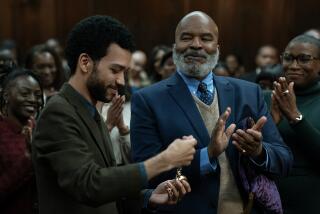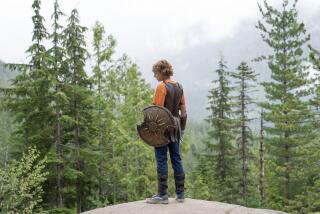From ‘Maleficent’ to ‘Game of Thrones,’ a magical time for adults
At the moment, “Maleficent” and its evil queen are burning up the big screen, and over on HBO, “Game of Thrones” and its Mother of Dragons are on fire too. Sequels to 2012’s “Snow White and the Huntsman” and 2010’s “Alice in Wonderland” are due in theaters in 2016, along with the fifth iteration of “Pirates of the Caribbean.”
A new version of “Pan” will land on screens next year, and the plotting Peter in “Once Upon a Time” will begin another season on ABC in the fall. Hugh Jackman will play Blackbeard in “Pan,” while John Malkovich’s Blackbeard is getting a head start in “Crossbones,” NBC’s new drama series.
These are magical times for adults. We are awash in fairy tales made for the grown-up set. And given their tremendous popularity, fairy tales are becoming the escapist antidote of choice to help weather stressful times. It’s not that kids are being shut out of the game, it’s rather that a rising tide of these entertainments have an older crowd as their primary, not secondary, target.
In aging up, the sensibility shift is a subtle one. Think of it as the difference between the all-ages embrace of “The Wizard of Oz” and the more acerbic edge of “Wicked.” Or the way “The Lord of the Rings” — both J.R.R. Tolkien’s original trilogy and Peter Jackson’s film adaptations — delves into more mature themes than “The Hobbit” does. .
Why are we grown-ups in such a fable-lous mood?
Thorny modern times saturated with entrenched dilemmas, fractious politics and endless global uprisings make the idea of a little magic quite appealing. But it is also the way fables handle the subtext, using mystical worlds as a prism for problems, that allow us a fresh look without the tale being clouded by contemporary culture.
As to Hollywood’s interest in the genre, it’s as simple as follow the money. From the billions Jack Sparrow has raked in for the “Pirates of the Caribbean” franchise to the $70-million opening weekend “Maleficent” just had, there is money to be made in fairy tales for the post-adolescent audience. Operating on the “Field of Dreams” inverse, if you come, they will build it.
At the core, fables in film and TV offer what they have from the time they were passed from one generation to another around campfires — a heady blend of fanciful escapism and harsh reality. It is magical to see Maleficent spread her wings and soar, horrific to watch her betrayer hack them off to weaken her power, easy to read the subtext. On screens large and small, it is also a genre not shy about employing a little melodrama in the telling.
Advancements in digital effects have certainly made it possible to conjure up incredible magic — Daenerys’ dragons in “Game of Thrones,” Maleficent’s wings, the unending mischief cooked up by Mr. Gold, a.k.a Rumpelstiltskin, in “Once Upon a Time,” to cite a few. But as always, it is the stories underneath and their emotional underpinnings that are so fundamental to capturing the crowds.
In earlier days, before niche marketing etched out great generational divides in entertainment, the allegories were for everyone. Whether it was the poignancy of Antoine de Saint-Exupery’s “The Little Prince,” the delicious fear of Maurice Sendak’s “Where the Wild Things Are” or the cautionary tale about desire found in Italian novelist Carlo Collodi’s “The Adventures of Pinocchio,” the stories inspiring the films might affect adults and children differently, but they were relatable and touched the emotions of all ages.
As Hollywood got involved, the generational pie slicing began in earnest. Though there might be cultural references thrown in here and there to keep parents from squirming through kids fare, fairy tales for the most part were relegated to youngsters. When a film like 1987’s “The Princess Bride” with Robin Wright or 2007’s “Enchanted” with Amy Adams turned up, part of the magic was in how out of the ordinary those movies felt.
It’s a tricky feat. Not quite getting that balance is “Noah,” director Darren Aronofsky’s biblical allegory from this year starring Russell Crowe and Jennifer Connelly. Despite its sci-fi-ish rock-monster angels that do not feel much like something out of Genesis, the movie is in a sense too literal, too polemical to appeal to either faith-based or mainstream audiences. “Maleficent,” in contrast, cloaks a feminist re-imagining of the old folk tale in humor and pathos, Angelina Jolie’s evil queen moving deftly between those poles.
There is much to be said for the flights of fancy these tales allow filmmakers and TV’s show runners. In “Snow White and the Huntsman” — unlike in Disney’s 1937 animated “Snow White and the Seven Dwarfs” — Kristen Stewart’s Snow is no helpless maiden; nor is Ginnifer Goodwin’s in “Once Upon a Time.” Both reflect contemporary attitudes about women’s roles, but ever so lightly.
The adventures are often so massive, the worlds so complicated, that what the tales need as much as creative invention is time. The two that have done it the best — “The Lord of the Rings” on film, “Game of Thrones” on TV — are different stories, but they connect with audiences for many of the same reasons.
Brilliant casting, of course, gripping stories, to be sure, stunning creativity, absolutely — all work to make these New Age fairy tales for grown-ups appealing for their entertainment value alone. But more than that: While men who are monsters battle for power, as petty jealousies between queens rage across continents and cultures, where honor and nobility are as rare as any gem and true love fights for survival — without dragons and fairies and swords with mystical powers, it might sound too much like yesterday’s news. Oh, but with them, something enchanting happens.
More to Read
Only good movies
Get the Indie Focus newsletter, Mark Olsen's weekly guide to the world of cinema.
You may occasionally receive promotional content from the Los Angeles Times.







